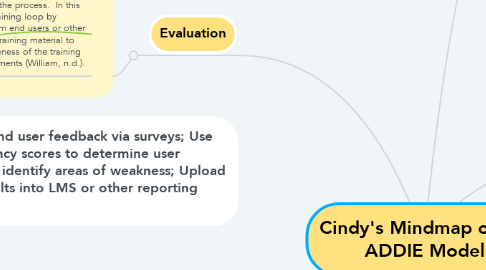Cindy's Mindmap of the ADDIE Model
by Cindy Cullen

1. Analyze
1.1. This is the first step in the process. The work that happens in this phase involves identifying why the training is needed, who the audience is going to be, conducting a inventory of training materials to see what you already have and what's missing. All questions regarding the who, what, when, how and why of the training should be answered here (Quigley, 2018).
2. Design
2.1. This is the second step in the process. In this phase you create a high level overview of what your training should look like - what type of assessments and exercises will be used for the training, how many topics are going to be covered and how long is the training, etc. (The Learning Exchange, n.d.).
3. Development
3.1. This is the third step in the process. In this phase you bring your training materials to life and upload into whatever delivery method will be used for the training and test it to ensure it is working the way it was designed (William, n.d.).
4. Implementation
4.1. This is the fourth step in the process. In this stage the training is delivered to the end users (Quigley, 2018).
5. Evaluation
5.1. This is the last step in the process. In this stage you close the training loop by receiving feedback from end users or other individuals about the training material to determine the effectiveness of the training and plan any enhancements (William, n.d.).
6. Steps: - Identify why the training is needed; Identify who the learners are; Identify the date the training needs to be completed by; Make a list of the resources needed for each step in the training (classrooms, LMS, staff, etc).
7. Steps: - Develop a training curriculum broken down by topic and duration of each topic; List out the different assessments that will be used; Create a lesson plan
8. Steps: - Create exercise booklets; Create quick start guides; Upload training material into the LMS; Assign the learning to a test group in the LMS; Make necessary tweaks
9. Steps: - Send out announcements about the training to the group of end users being trained with training start and end dates; Deliver the training - if by LMS then activate the training to be available on the date it should or if by in-person training then roll out the training in a classroom or other learning setting
10. Steps: - Collect end user feedback via surveys; Use end user proficiency scores to determine user performance and identify areas of weakness; Upload performance results into LMS or other reporting tool
11. References: Quigley, E. (2018, March 29). ADDIE: 5 steps to effective training. Retrieved from https://www.learnupon.com/blog/addie-5-steps/ The Learning Exchange. (n.d.). Creating your course using the a.d.d.i.e. model of instructional design. Retrieved from https://www.mc.vanderbilt.edu/documents/The%20Learning%20Center/files/ADDIE_JOB%20AID.pdfWilliam, A. (n.d.). The addie model. Retrieved from https://opentextbc.ca/teachinginadigitalage/chapter/6-5-the-addie-model/
12. References: Quigley, E. (2018, March 29). ADDIE: 5 steps to effective training. Retrieved from https://www.learnupon.com/blog/addie-5-steps/ The Learning Exchange. (n.d.). Creating your course using the a.d.d.i.e. model of instructional design. Retrieved from https://www.mc.vanderbilt.edu/documents/The%20Learning%20Center/files/ADDIE_JOB%20AID.pdf William, A. (n.d.). The addie model. Retrieved from https://opentextbc.ca/teachinginadigitalage/chapter/6-5-the-addie-model/


